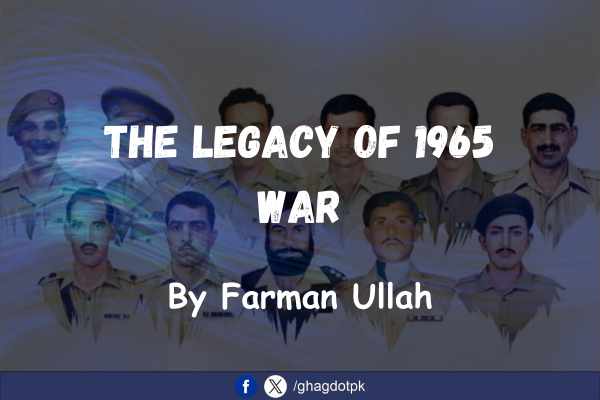By Farman Ullah
What Happened on September 6, 1965?
On September 1965, India launched a surprise attack on Pakistan, sending troops across the border without warning. The Indian army targeted several key areas, including Lahore, Sialkot, and parts of Sindh. The fighting continued for over two weeks until the UN stepped in and helped negotiate a ceasefire on September 22.
The Lahore Incursion
On September 6, 1965, India launched a surprise attack on Lahore, violating international law and the UN Charter. The three-pronged assault was met with fierce resistance from Pakistan’s army and air force, leading to significant Indian losses. Despite being outnumbered, Pakistan successfully repelled the invasion, defending its territory against Indian aggression.
The Sialkot Invasion
On September 8, India launched a major attack on Sialkot, but Pakistan’s military held strong. The resulting tank battles were the largest since WWII. Despite being outnumbered, Pakistan repelled the invasion, inflicting heavy casualties on India. The nation came together, with civilians contributing to the war effort in various ways, showcasing remarkable resolve and unity in the face of adversity.
How Did the War Come to an End?
The Soviet Union, which had remained neutral during India’s and Pakistan’s conflict, then acted as a mediator in Tashkent. On December 8, a Soviet government communiqué formally stated that Indian Prime Minister Shastri and Pakistani President Ayyub Khan would meet in Tashkent on January 4, 1966.
The USSR’s efforts at mediation led to the conclusion of the war, and a peace treaty was signed in Tashkent.
The Martyrs of the 1965 War
So many people have lost their lives fighting for our country in this war. These are; Major Aziz Bhatti,Squadron leader Muhammad Mehmood Alam, Squadron leader Sarfaraz ahmad rafique, Aircraftman Anwar Hussain, Squadron Leader Alauddin Ahamd, Air Marshal Muhammad Noor khan and many more. Among these Martyrs, Major Aziz Bhatti won the highest Nishan e Haider award for his exceptional role in defending the Bedian region of Lahore in 1965.
How is Defence Day Celebrated in Pakistan
Every year, Pakistan celebrates this day and pays tribute to the martyrs with great zeal and zest. The multiple ways we honor the sacrifices of our brave heroes are as follows:
Change of Guards Ceremony
The ‘change of guards’ ritual occurs every 6th of September at Mizar-e-Qaid and Iqbal’s mausoleum. The new cadets of the Pakistani Army replace their comrades on guard duty.
Parades
The Pakistan Army displays its heaviest weaponry, including tanks, missiles, and aircraft, each year as part of the celebrations on Defence Day. The parades and air shows occur across many cities in Pakistan.
6th September 1965 War Heroes
September 6 is a day of great significance in Pakistan, a day to honor the brave men who fought and embraced martyrdom for their country in 1965. It is a day to reflect on their courage, their love for Pakistan, and the ultimate sacrifice they made to keep their nation safe.
In 1965, Pakistanis came together with an unwavering determination to defend their country against an enemy that launched a sneak attack under the cover of darkness. The enemy sought to undermine Pakistan’s sovereignty and the freedom of its people, but our heroes stood strong.
Major Raja Aziz Bhatti: A Symbol of Bravery
Major Bhatti led his company in the Burki area near Lahore, showing extraordinary courage in the face of relentless artillery and tank attacks. For five straight days and nights, he defended the crucial BRB canal, rallying his men to hold their position. Sadly, he made the ultimate sacrifice on September 10, giving his life to protect his country.
Squadron Leader Mohammad Mehmood Alam: Aerial Combat Hero
Squadron Leader Alam exhibited remarkable prowess in aerial combat, shooting down two enemy Hunter aircraft and damaging three others. He accomplished a historic feat by destroying five enemy Hunter aircraft in less than a minute, earning him the Sitara-e-Jurat.
Squadron Leader Sarfaraz Ahmed Rafiqui: A True Hero
Rafiqui led a small team of F-86s on a risky mission to attack Halwara airfield, knowing they’d face heavy enemy fire. When his guns jammed, he didn’t give up, ordering his team to keep fighting and defending them in his unarmed plane. His bravery and sacrifice allowed his team to take down more enemy jets, earning him the Hilal-e-Jurat.
Aircraftman Anwar Hussain: Devotion to Duty
Aircraftman Hussain showed unwavering courage and devotion to duty when his station came under enemy rocket fire. Despite being the sole person on duty, he fought the fire using available resources and managed to control it, saving valuable equipment. His selfless act of bravery earned him the Tamgha-e-Jurat.
Squadron Leader Alauddin Ahmed: Leadership and Courage
Ahmed led his squadron on twenty combat missions, always pushing forward, even when things got tough. In his final mission, he took a huge risk, destroying a crucial ammo train at Gurdaspur, even though his plane was badly damaged. His bravery and sacrifice earned him the Sitara-e-Jurat award.
Air Marshal Malik Nur Khan: A Founding Father
Air Marshal Khan, a founding father of the modern Pakistan Air Force, achieved an extraordinary victory during the 1965 war, leading a force significantly outnumbered. His remarkable valor earned him the Hilal-e-Jurat, Sitara-e-Quaid-i-Azam, and Sitara-e-Pakistan.
These heroes, alongside the countless soldiers who laid down their lives in defense of their homeland, embody the relentless determination and unwavering loyalty of Pakistan’s military forces during the 1965 confrontation with India. Their legacy serves as an eternal source of inspiration, continuing to shape the ambitions of future generations.






